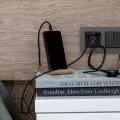Agnieszka: Observing your work over the years, I see empathy and, until a few years ago, a very avant-garde attitude towards nature, naturalness and wildness, which you were already introducing in your projects. I recall the single-family house, planned to be overgrown with weeds, or the mountain in Constitution Square, thanks to which weeds grew in the very center of the city, and the parking lot was hidden underground. You were ahead of the times. What are you doing now?
Alexandra: I have been operating in a niche all this time. My studio has been in the same tiny place in a gap between blocks with a small window from the street for fifteen years. My team is very small, we work in a group of three to six people. We design houses, parks, installations, sculptures, recently we designed a quarter for more than three hundred public housing units, now an elementary school, I also write books, do set designs, but my greatest passion is the dirt of this city, that is, spaces of the worst and unwanted. I like to question prestige in architecture, I like places that are on the margins, bazaars, kibbles, garbage cans. I also like the marriage of art and architecture, so that art goes beyond the museum, comes off the pedestal. I've been working on bazaars since my college and diploma days at the Defilad Square in Warsaw, where I wanted to protect the jaws and stargates as a testimony to the transformation. Then along the way there were several conceptual projects for markets, the Różycki bazaar, Bazaristan, which is an exhibition-performance market in Wroclaw, several competitions, then the revitalization of the Bakalarska market in Warsaw, which is the most diverse and cosmopolitan place in Poland, and now the construction of a bazaar in the municipality of Blonie has just started. Next year, the revitalization of the marketplace in Biala Podlaska will begin. I am very happy that after ten years of writing and researching bazaars, I can finally turn theoretical knowledge into practice, although I do it very slowly and on a small scale. These displaced spaces are slowly beginning to come out of the shadows.
A mock-up of the project to revitalize the bazaar on Ptasia Street in Wroclaw at the "Bazaristan" exhibition, curated by Aleksandra Wasilkowska
© PostNovki
Agnieszka: You call bazaars shadow architecture. What does that mean?
Aleksandra: It's a repressed architecture, a dirty architecture, an unwanted legacy, a bastard child of transformation. In psychoanalytic terms, informal architecture is a metaphor for the subconscious of the city. The term "shadow architecture" refers to Jung's psychology and his notion of the shadow archetype, that is, human fantasies, hidden fears and shame repressed into the subconscious. In the context of the city, these are places we are ashamed of and love at the same time.
This was Jarmark Europa, this is Bakalarska Market or Flower Exchange, these are other smaller bazaars, street trading, vegetable stalls at bus stops, which began to disappear from the cityscape as part of the Euro renovation. I'm interested in how grassroots architecture and the whole urban gray area works. How self-organization and informal construction form the economy and urbanism, although they are being pushed out of it by the official system and regulations. Bazaars are the most democratic space and are not necessarily just for consumption. They have huge attendance, are popular, egalitarian and inclusive, open to all. That's why I think they should be designed like museums, theaters, like contemporary social palaces.
Agnieszka: You moved with the concept of a modern market from Defilad Square, where you started, to the outskirts of the city?
Aleksandra: It's easier to operate on the periphery of the system. I've recently changed my strategy a bit and started working in smaller cities and municipalities. In Warsaw, you often have to convince officials at a lower level to make some changes in thinking, I hear all the time that it's impossible to plant trees somewhere because the networks are too close, or that it costs too much to maintain greenery or recover gray water. Working in a big city also often involves a lot of bureaucracy. Sometimes good ideas are blocked somewhere at a lower official level. It would seem that today, in the midst of the pandemic, no one should question the need for radical greening of the city anymore, that some things are already obvious and overworked, and yet still many officials want to follow the old paths. The Greenery Board is doing a good job, but many officials in individual districts at lower levels still believe that the most important thing is parking spaces and a well-paved yard. It is easier, I feel, to work in smaller municipalities, where there is not as much bureaucracy and officials are more involved. At the moment I'm working in the municipality of Blonie near Warsaw on the revitalization of the local market, and I'm delighted with how open and progressive the municipality is. The mayor even managed to convince the opposition in the municipality council that the market could be a park at the same time. Nearly half a thousand trees and more than a thousand perennials and climbing plants will grow on the same area alongside the pavilions and market tables. Rain gardens will also be created there, there will be a great deal of water retention, bird and insect boxes. My experience so far proves that it is easier to implement progressive solutions in smaller municipalities. It seems to me that it is very true to say that today the center is on the periphery.
Błonie Market revitalization project, proj.: Pracownia Architektoniczna Aleksandra Wasilkowska
Agnieszka: Why did you get involved with bazaars in the first place?
Aleksandra: As a student in France, I used to meet with friends every weekend at the market in the central city square. We had such a ritual that we bought vegetables and fruits for the week, and then often ate what we bought at cafes next to the market. On Sunday, instead of going to mass, people just went to the bazaar. In France, bazaars are a great place for everyone to meet spontaneously. They are not a fenced-off, shameful space somewhere on the outskirts of a neighborhood, but the heart and essence of urban life. At the time, there was a great discussion in Warsaw about the jaws and halls on Parade Square, but there was also an ongoing critique of Jarmark Europa and other smaller markets that spilled out onto the streets after the transformation. The 10th Anniversary Stadium, or Jarmark Europa at the time, was bustling with life. I liked that this was the one place that was so crowded with all of Warsaw, very different social groups, migrants and people from out of town. The famous soup lane was a meeting center on weekends without any top-down planning. I felt very sorry for the social potential of the bazaars, and began to wonder what could be done to civilize the bazaars and street trade so that they would be socially acceptable, and so that the markets would begin to be included in the city's local plans.
Project for revitalization of Błonie market, design: Pracownia Architektoniczna Aleksandra Wasilkowska
In France, I defended my diploma on Defilad Square. I proposed protecting and expanding the bazaar as a counter to the Palace of Culture. I also prepared a new urbanism, which works not according to a closed, composed plan, but according to the open principle of growth by adding more buildings. The project evolved, and I produced a publication on the subject, "Warsaw as an Emergent Structure," with new thinking on more bottom-up urbanism. It was also a kind of manifesto saying that the city center should be as inclusive and accessible as possible, that functions such as bazaars can be the center, that the city center is not just prestige, a museum and a theater, that the center should be an amalgam, connecting different social bubbles and not creating ghettos for just one social class. You leave the office located in the Palace of Culture and buy a carrot or a towel. You use the city bathhouse or social assistance and enter the museum. I feel that as a privileged person, I have a duty to fight to ensure that modernization does not exacerbate social stratification. Architecture and urban planning can be tools to bring different social groups together. This is difficult and utopian, but I feel it is necessary to fight for this, to fight for urban policy and local plans to create an inclusive space, open to different social groups. In this way we will train empathy and tolerance for otherness.
Agnes: You were involved in toilets. Is that also shadow architecture?
Aleksandra: Eighteen years ago, walking around Warsaw with my little son in a stroller, I had nowhere to change him, there were no toilets in the parks, I felt that it was a form of discrimination, that parents with small children and the elderly had trouble moving freely around the city because of this. As with the bazaars, my personal experience translated into architectural practice. In parallel to designing, I was engaged in researching and describing these perplexing topics. I have published several books in the "Architecture of Shadow" series, which revolve around my obsessions with the urban subconscious, topics that are a little dirty, a little repressed, such as bazaars, street commerce and just toilets. For me, working on books is a good excuse to explore themes that intrigue or seduce me in some way. That's why there are so many different issues in a book about toilets: from artistic experiments, to interviews with shawkers, to an analysis of the typology of toilet bowls. What I manage to collect while working on the books, I later apply to my projects. For example, in Warsaw toilets, which already stand in many places in Warsaw, I managed to eliminate the gender division, I managed to make a large changing table and a place to put a stroller, in a situation when a parent with a small child needs to use the toilet. These are small things, but crucial so that the architecture does not exclude anyone. I would very much like it to be possible to build toilets in the school we are designing now that do not discriminate on the basis of gender. Because, first of all, the construction law is still structured in such a way that, in total, along with urinals, more so-called eyesores must be built in men's toilets than in women's toilets, and there are no toilets for people who don't feel comfortable in either men's or women's toilets. So toilets still exclude, and I want to change that in my projects.
Automatic Warsaw Toilet, proj.: Pracownia Architektoniczna Aleksandra Wasilkowska, Marek Happach
photo: Maciej Landsberg
continued conversation on next page













































